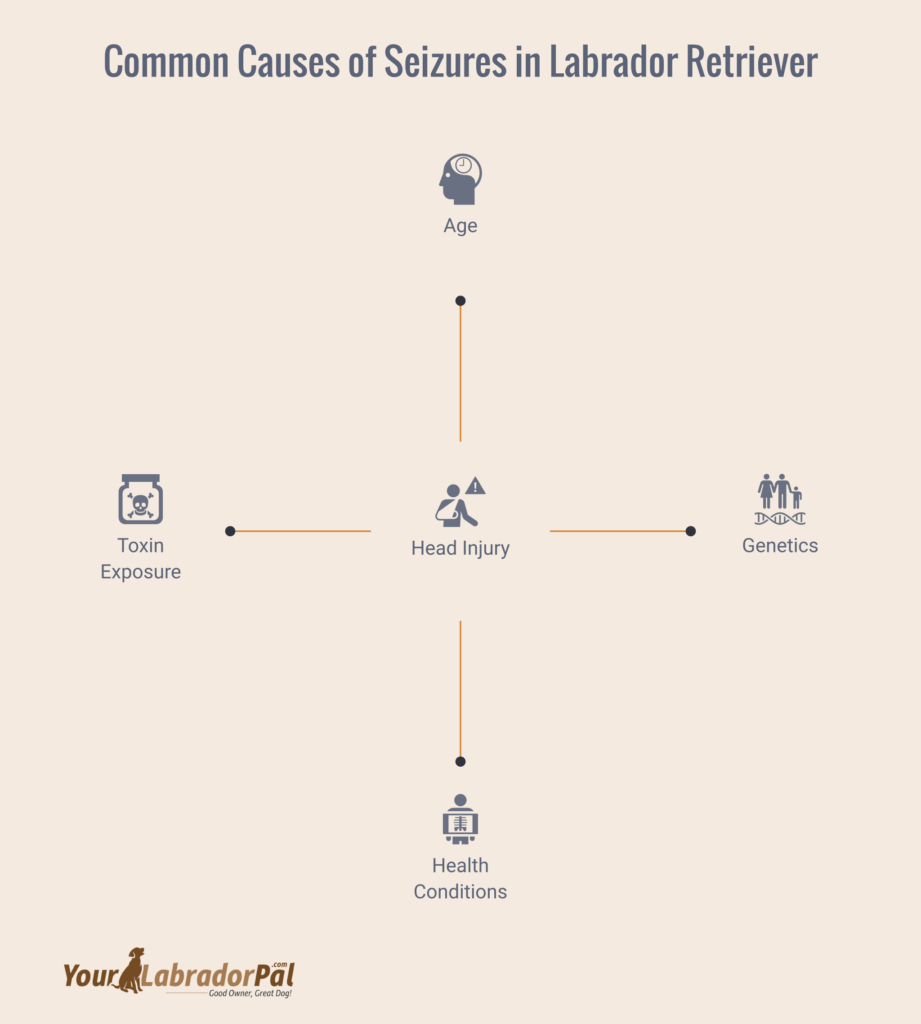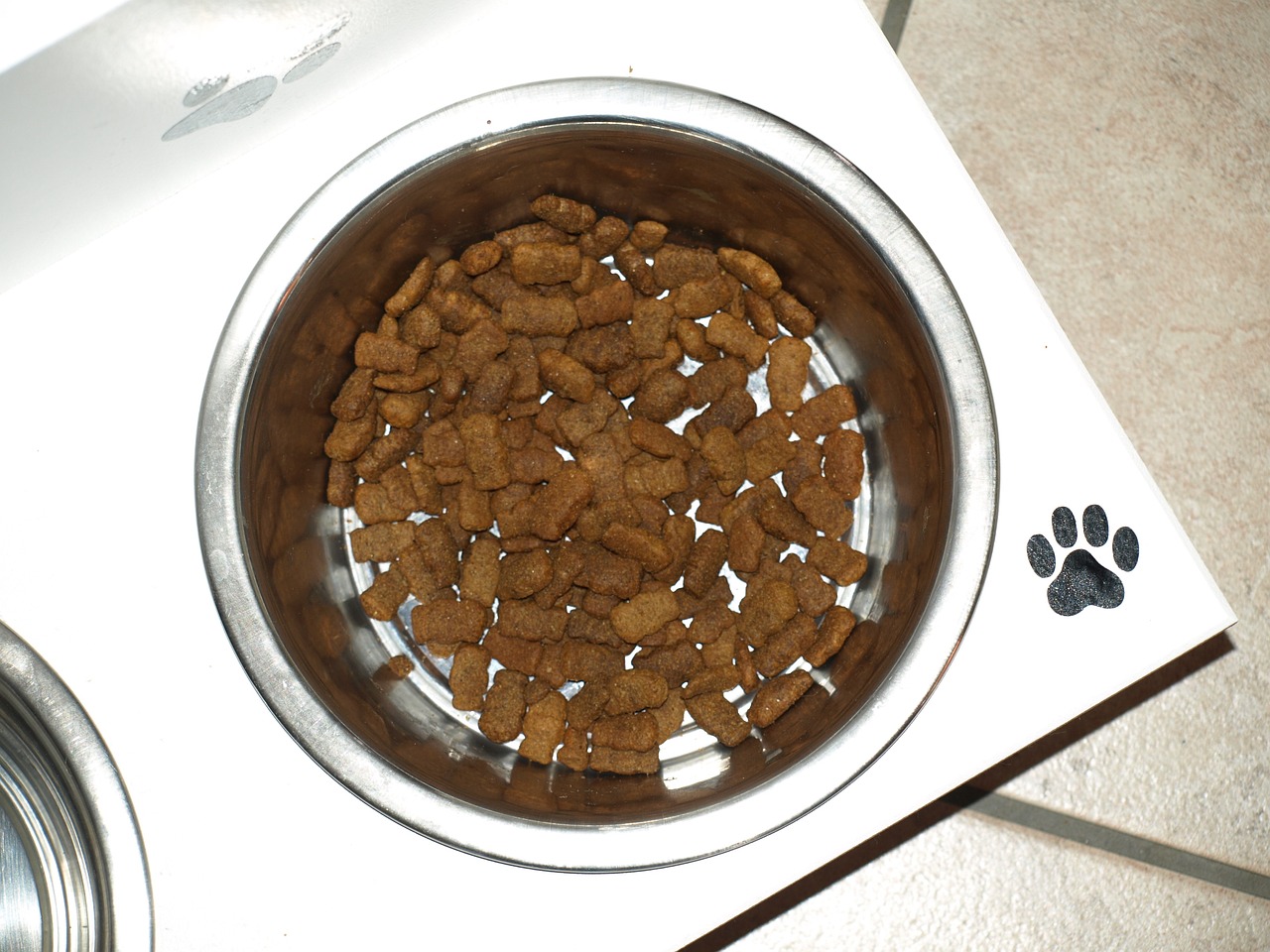Exploring the Reasons Why Do Labrador Retriever Have Seizures?
Have you ever wondered why do labrador retriever have seizures? It’s a question that has been on my mind for a while, especially since I have a labrador retriever. Seizures can be a scary thing, not just for dogs but for their owners as well. After doing some research and speaking with my veterinarian, it turns out that there can be a variety of reasons why labrador retrievers experience seizures.
So, It’s important to understand that while seizures can be unsettling, there are ways to manage and treat them. So, if your furry friend has been struggling with seizures, I want you to know that you are not alone and there is hope. In this blog post, I will outline some of the most common causes of seizures in labrador retrievers and how you can help manage and how to stop seizures in dogs immediately.
What Exactly Is Seizure in Labrador Retrievers?
Seizure, in general, is sudden and uncontrollable electrical activity in the brain. Seizure in Labrador retrievers is no different, except that it affects this particular breed of dogs. Seizures in Labradors can be classified as focal or generalized seizures. While focal seizures affect specific parts of the brain, generalized seizures affect both sides at once and can be more dangerous.
While seizures can occur in any dog breed or age, Labrador Retrievers tend to have a higher frequency of seizures than other breeds. Seizures can range from mild to severe and last a few seconds to several minutes. The frequency of seizures can also vary, from one-time occurrences to frequent episodes.
Types of Labrador Retriever Seizures
Before diving into some of the most common causes of seizures in labrador retrievers, it’s essential to understand the two types.
1: Focal Seizures
Abnormal electrical activity in a specific area of the brain causes Focal Seizures, which are also known as partial seizures. Symptoms of focal seizures include twitching in one part of the body, drooling, and abnormal behavior. Focal seizures can last anywhere from a few seconds to a few minutes. During a focal seizure, your dog might appear to be completely aware of what’s happening, or it might appear confused.
2: Generalized Seizures
Generalized Seizures, or Grand Mal Seizures, are dogs’ most common seizures. This type of seizure tends to affect the entire brain, causing your dog to lose consciousness. You will notice that your Labrador Retriever goes stiff and falls to the ground. They may convulse and drool, which can be a scary experience for pet owners. Generalized seizures can last between a few seconds to several minutes.
3: Psychomotor Seizures
Psychomotor Seizures, or Complex Partial Seizures, is a mix of focal and generalized seizures. During Psychomotor seizures, your Labrador Retriever may exhibit compulsive behavior, such as circling or biting its own tail. You may also notice that they have a fixed gaze, and their movements are repetitive and non-purposeful. Psychomotor seizures can last from 30 seconds to several minutes.
4: Cluster Seizures
It is not uncommon for Labrador Retrievers to experience this seizure. Usually, they will have several seizures within a relatively brief time frame, usually within 24 hours. These seizures can be scary for the dog and the owner, and monitoring your dog for any signs that an episode is about to start is essential. The good news is that with proper treatment, many Labrador Retrievers can manage these types of seizures and lead happy, healthy lives.
5: Idiopathic Epilepsy
It is a condition that is inherited and can manifest itself in dogs between the ages of one and five years old. The condition may cause seizures that last anywhere from a few seconds to several minutes. These seizures can be generalized or focalized. Typically, a generalized seizure is more severe. With idiopathic epilepsy, the seizures are usually not life-threatening, but they can significantly impact the Labrador Retriever’s quality of life if left untreated.
6: Status Epilepticus
In some cases, a Labrador Retriever may experience status epilepticus, which is a medical emergency. Status epilepticus is when a dog has a seizure that lasts over five minutes or has repeated seizures without regaining consciousness. This type of seizure can be life-threatening. It is essential to seek immediate veterinary attention for status epilepticus. If status epilepticus is left untreated, it can lead to brain damage, and in the worst-case scenario, it can be fatal.
Remember, always consult your veterinarian if you are concerned about your dog’s health or well-being.
Why Do Labrador Retriever Have Seizures?
Now that we better understand the different types of seizures in Labrador Retrievers let’s look at some of the most common causes.
☛Head Injury
A head injury is one of dogs’ most common causes of seizures. If your Labrador Retriever has experienced head trauma in the past, seizures may occur as a result. Seizures caused by head injuries could happen months or even years after the initial trauma. If you suspect your Labrador Retriever has experienced a head injury, you must speak with your veterinarian.
☛Age
As dogs age, they become more prone to seizures. It is especially true for Labrador Retrievers, who typically have 10-12 years of lifespan. Older dogs may experience age-related seizures, which are typically not harmful. However, speaking with your veterinarian is still important to rule out any underlying health issues.
☛Genetics
Genetics can also play a role in seizures in Labrador Retrievers. If your dog’s parents or siblings have experienced seizures, your dog may have inherited a predisposition to seizures. Genetic testing can sometimes help identify potential conditions that could lead to seizures.
☛Health Conditions
Some health conditions can also trigger seizures in dogs. For example, if your dog has liver or kidney disease, seizures can occur as a result. Other conditions that can cause seizures include diabetes, heart disease, and brain tumors. If you suspect your Labrador Retriever is experiencing seizures due to an underlying health condition, speak with your veterinarian as soon as possible.
☛Toxin Exposure
Toxin exposure can lead to seizures in dogs. So what toxins can cause seizures in dogs? If your Labrador Retriever accidentally consumes a toxic substance such as chocolate, pesticides, or cleaning products, seizures can occur. It’s important to keep toxic substances out of reach and to monitor your dog closely to prevent accidental ingestion.
By understanding the potential causes of seizures in Labrador Retrievers, you can take steps to reduce your dog’s risk.
Identifying Seizures in Labrador Retrievers
It can be a scary experience for the dog and the owner, but identifying the signs and symptoms of seizures in your Labrador Retriever can help you provide the proper care and support your furry best friend needs. Below are the common signs and symptoms of seizures in Labrador Retrievers and what to do if your dog experiences one.
1: Uncontrolled Shaking and Twitching
The most obvious sign of a seizure in Labrador Retrievers is uncontrolled shaking or twitching of their body. Seizures can affect different body parts, including the legs, head, and neck, causing your dog to convulse or tremble uncontrollably. During a seizure, your dog may fall over and lose consciousness, and their limbs may become stiff or rigid. These tremors can last for several seconds to minutes, and your dog may be unable to move or respond to you during a seizure.
2: Changes in Behavior and Mood
Your dog may become anxious, confused, or disoriented during a seizure or immediately after. It may also exhibit unusual behavior, such as licking themselves excessively, pacing, or scratching. The pup may also become hypersensitive to touch or sound, which can cause it to snap or growl at its owners or other people.
3: Loss of Consciousness
Labrador Retrievers experiencing seizures may also lose consciousness, making them unable to respond to stimuli. This can cause them to experience a blank stare or a dazed, unresponsive look in their eyes, which can be unnerving for their owners. In addition, some dogs may become incontinent during a seizure and urinate or defecate without control. When your dog begins to regain consciousness after a seizure, it may appear disoriented and not recognize its surroundings or owners.
4: Repetitive Movements
In some cases, Labrador Retrievers experiencing seizures may exhibit repetitive movements. It can include running in circles, compulsively barking, or chewing their jaws. These actions can be dangerous for your dog and may cause injuries during a seizure. If you notice repetitive or unusual movements during a seizure, try to move your dog to an area free of any objects that could be harmful, such as sharp corners or furniture.
5: Post-seizure Symptoms
After a seizure, your Labrador Retriever may take several hours or days to recover fully. They may exhibit post-seizure symptoms such as excessive sleepiness, lethargy, or disorientation. They may also have trouble walking or standing because of muscle weakness caused by the seizure. You may need to help your dog walk or even carry them to and from the outside to relieve themselves if they are too weak to do so alone.
It is important to note that all of these symptoms may vary depending on the type and severity of the seizure your dog is experiencing.
Diagnosis of Seizures in Labrador Retrievers
At the initial visit, your veterinarian will ask questions about your dog’s medical history and their symptoms. They will also conduct a physical examination to assess their overall health. Neurological tests, such as reflex testing, balance testing, and gait evaluation, will be conducted to check for abnormalities.
After the initial examination, your veterinarian may recommend lab testing. The blood test may reveal any underlying metabolic or hormonal issues that could cause seizures, such as liver or kidney diseases, low blood sugar, or anemia. Electrolyte analysis measures the amount of salts in your dog’s blood, which is essential to keep the body hydrated and maintain proper nerve and muscle function. Your veterinarian may also conduct a thyroid screening test, as a thyroid abnormality can cause seizures.
Further testing may include imaging tests, such as MRI and CT scans, to detect abnormalities in the brain or an electroencephalogram (EEG) to determine brainwave patterns and the frequency and duration of seizure activity.
If your veterinarian confirms that your Labrador Retriever has seizures, they may prescribe medication to control and manage the seizures.
Labrador Retriever Seizures Treatment Options
The most common treatment for seizures in dogs is medication, and a veterinarian often prescribes it. Two of the most effective medications in treating seizures in dogs, including Labrador Retrievers, are :
💊Phenobarbital and Zonisamide
Phenobarbital is an anticonvulsant medication that works by stabilizing the nerve cells in the brain that are involved in causing seizures. On the other hand, Zonisamide is a newer medication prescribed in combination with other anticonvulsant drugs. Both medications have certain side effects, such as lethargy and increased thirst, so monitoring your dog closely when they are under medication is crucial.
💊Supportive Care
Supportive care is another crucial aspect of treating seizures in Labrador Retrievers. This includes ensuring your pet has access to fresh water at all times, a comfortable and safe environment, and a healthy diet. A healthy diet can help reduce the frequency and severity of seizures. A diet that includes medium-chain fatty acids as the fat source may be able to decrease seizures. You can consult your veterinarian to recommend a diet that will work for your dog.
💊Complementary Therapies
Complementary therapies like acupuncture can help reduce seizures in dogs. Acupuncture involves the insertion of needles into specific points on the body to balance the energy or “chi” and stimulate the body’s natural healing abilities. It can help soothe your dog’s nervous system, decreasing the frequency of seizures.
Another supportive care option is CBD oil derived from the hemp plant. CBD oil has been found to have anticonvulsant properties, making it an effective treatment for seizures. It is essential to consult your veterinarian before giving your dog CBD oil, as it may interact with other medications your pet may be taking.
How to Reduce the Risk of Seizures in Your Labrador Retriever
It’s important to understand that seizures can happen without warning. So, taking measures to reduce the risk of seizures in your Labrador Retriever is essential.
1: Keep Your Labrador’s Stress Levels Low
As Labradors are known to be a highly excitable breed, too much excitement or stress can trigger a seizure. Help your dog possess calm behavior by ensuring a comfortable bed, enough space to run around, and regular exercise. If you prefer keeping your dog in a crate, make sure the crate is large enough to stand, turn, and lay down in.
2: Feed Your Dog a Healthy Diet
Your Labrador’s diet plays a significant role in its overall health, including the health of the brain and nervous system. Providing your dog with a balanced and nutritious diet can help lower the risk of seizures. Avoid giving chocolate, caffeine, and grapes, as these foods can be toxic to dogs. Furthermore, ensure your dog has fresh and clean water to keep them hydrated.
3: Regular Checkups with a Vet
Frequent visits to your dog’s vet are essential to monitor their body and health. A vet can easily identify health problems before they become bigger issues. Regular checkups help ensure your dog maintains excellent health and minimizes the chance of seizures. Furthermore, the vet can recommend supplements, if necessary, that can aid in preventing seizures.
4: Manage Your Labrador’s Medications
If your Labrador is under medication, follow the prescribed dosage. Consult your vet before adding new supplements, and rarely change their dosage without the doctor’s recommendation. Medications can trigger seizures if not appropriately administered and carefully regulated.
5: Keep Your Environment Safe
Ensure that your Labrador’s everyday environment is safe and secure. It means removing any sharp or hazardous objects, preventing your Labrador from ingesting anything that could be dangerous to their health, removing any outdoor plants or flowers that may be toxic to them, and always keeping a watchful eye on your Labrador when you’re out.
Remember, good preventative care is key to ensuring the best outcome for our pets. Regular checkups, a healthy lifestyle, and a watchful eye are essential to keeping your Labrador Retriever healthy and happy!
Frequently Asked Questions
Q: Is epilepsy more prevalent in Labrador Retrievers than other dogs?
No evidence suggests that Labrador Retrievers are more likely to have epilepsy than other dog breeds. However, some genetic factors can make certain breeds more susceptible to seizures. For example, epilepsy is more common in breeds like Beagles and German Shepherds. Nevertheless, it’s important to note that seizures can happen to any dog breed, and many factors can contribute to the development of seizures.
Q: Are there any specific triggers that can induce seizures in Labrador Retrievers?
Dog seizures out of the blue can be triggered. So what can trigger a seizure in a dog? There are various factors, such as stress, excitement, exposure to certain chemicals, or even changes in the weather. Pay attention to your pet’s behavior and try your best to identify any potential triggers. Some common triggers include exposure to pesticides, certain medications, or even a change in diet. It’s always a good idea to talk to your veterinarian if you suspect something is triggering your pet’s seizures.
Q: Can seizures in Labrador Retrievers be life-threatening?
Seizures can be scary, but they are not always life-threatening. However, if your pet has a seizure, keeping them safe from harm is important. Move any nearby objects out of the way to prevent your pet from injuring themselves during the seizure. After the seizure has passed, keep your pet in a quiet, calm environment and monitor their behavior. It’s always a good idea to talk to your veterinarian if seizures occur regularly or if your pet is experiencing any other concerning symptoms.
Q: Can seizures in Labrador Retrievers be managed or controlled with medication?
Yes, seizures can be managed or controlled with medications. When my 3-year-old Labrador had its first seizure, I was terrified. I immediately rushed it to the vet, where he was prescribed anti-seizure medication. The medication reduced the seizure frequency and severity, relieving the distress caused by the episodes. However, every dog’s case is different; some may require stronger medication or a combination of treatments. It’s essential to consult a veterinarian for proper diagnosis and treatment.
Q: Are there any long-term effects or complications associated with seizures in Labrador Retrievers?
Seizures in Labrador Retrievers can have long-term effects and complications. Frequent seizures can lead to brain damage, personality changes, and loss of cognitive functions. Moreover, some medications that control seizures can cause liver or kidney damage over time. That’s why monitoring your pet’s health and consult with a veterinarian regularly is crucial. In addition, a well-balanced diet, regular exercise, and a stress-free environment can help reduce complications and improve your pet’s overall health.
Q: Can a Labrador Retriever have a single seizure and never experience another one?
Yes, a Labrador Retriever can have a single seizure and never experience another one. However, it’s not guaranteed. Seizures can be unpredictable and may occur months or even years after the first. If your pet has had a seizure, monitoring its behavior and keeping a record of the episodes is crucial. If you notice any changes in behavior or physical symptoms, contact your veterinarian immediately.
Q: How can I prepare for a seizure emergency?
Seizure emergencies can be scary and stressful, but proper preparation can ease anxiety and increase your pet’s chances of receiving timely treatment. First, educate yourself on the signs and symptoms of seizures. Make sure to keep your veterinarian’s contact information handy, and know the location of the nearest 24-hour emergency vet clinic. Prepare a first aid kit with essential items like a muzzle, blanket, and water bottle. Finally, train your dog to remain calm during a seizure by avoiding physical contact, removing harmful objects from the surrounding area, and keeping a safe distance from the pet.
Final Words
In conclusion, the mystery of why Labrador Retrievers have seizures can be a concern for pet owners everywhere. From personal experience, I can tell you that watching your beloved pet go through a seizure can be an incredibly alarming and emotional experience. While there may not be one definitive answer to why seizures occur in Labs, it is clear that genetic predisposition, environmental factors, and underlying health conditions can all contribute to this unfortunate affliction.
Despite the uncertainty surrounding this issue, remaining vigilant and proactive regarding your pup’s health is important. By visiting the vet and observing any changes in behavior, we can help our labs live the happy, healthy lives they deserve.










